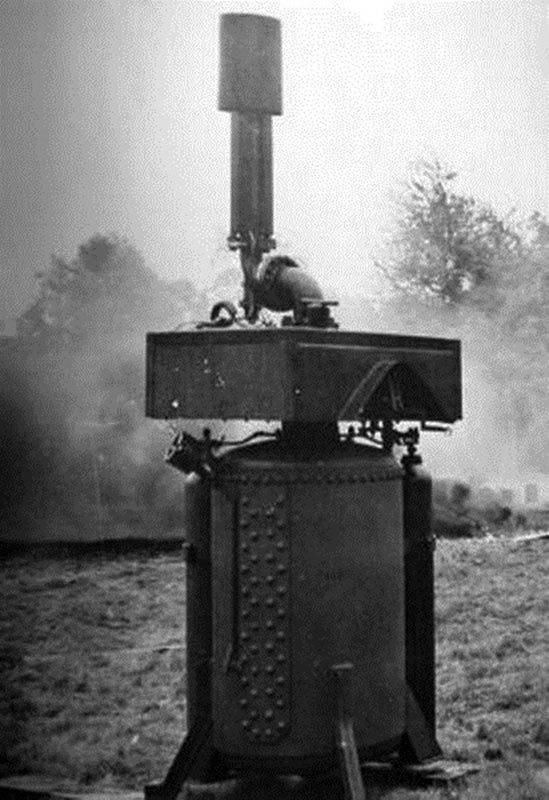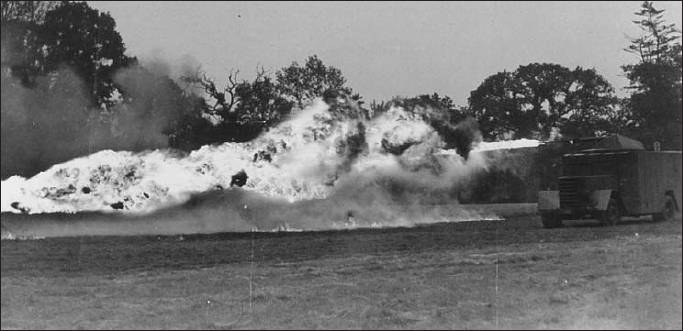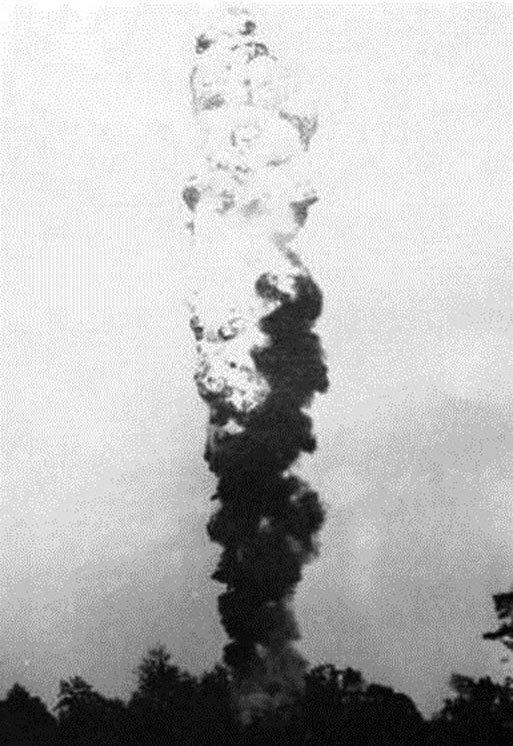Naval pattern vertical firing flamethrower (United Kingdom)
The reasons for the appearance of an unusual project were simple and understandable. At any moment, Nazi Germany could begin an amphibious operation, during which combat and transport were of particular importance. aviation. As a result, the air defense forces needed weapons to deal with enemy aircraft and airborne gliders. In addition, the new air defense systems were of great interest to the Royal Navy. fleet. The ships needed new effective means of combating torpedo bombers or bombers, capable of showing a certain superiority over existing weapons.
It was on the request of the fleet command that the development of perhaps the most unusual air defense system began. Fighting enemy aircraft and gliders was proposed using a large torch emitted by a land-based or ship-based system. It was assumed that the new anti-aircraft flamethrower will use the jet method of influencing the target and throw the combustible mixture strictly upwards. The customer, the class and the intended way of working were reflected in the name of the Naval pattern vertical firing flamethrower project - “Naval-type vertical firing flamethrower”.

General view of the Naval pattern vertical firing flamethrower system in a fixed configuration
According to reports, the beginning of a new project contributed to certain successes in the creation of self-propelled flamethrowers for the ground forces. In 1940, Lagonda introduced its own design of a flamethrower suitable for mounting on self-propelled chassis. This technique, called Cockatrice, was soon brought to mass production and was used with a certain intensity in the troops. Shortly thereafter, a proposal appeared that implied the adaptation of the existing structure to use on ships, boats and ships of the Navy.
The development of an unusual project was entrusted to the organization Department of Miscellaneous Weapons Development ("Department of the development of a variety of weapons"). The task of the DMWD department was to develop non-standard weapons based on original principles. During the years of the Second World War, the specialists of this organization created and tested a large number of specific weapons systems, which for the most part were not recommended for practical operation. Only a few units of promising samples confirmed their capabilities and were adopted.
In accordance with the new assignment, DMWD designers began to develop the Naval pattern vertical firing flamethrower. The specific method of using such weapons made some special demands on its design and individual characteristics. However, it was still possible to obtain acceptable parameters without the need to create any completely new mechanisms and principles of operation. From the point of view of the general architecture, the prospective flamethrower should have been a seriously increased weapon of the traditional construction of that time.
The first version of the "vertically firing" flamethrower was a direct development of existing products from Lagonda. On the carrier ship, it was proposed to mount a turret with a hose, next to which were placed tanks for fire mixture and compressed gas. Such a project did not require a major change in the design of the flamethrower: it was only necessary to change the mutual arrangement of its various elements and redesign the pipelines accordingly.
Soon a flamethrower similar to that used on the Cockatrice combat vehicle was installed on the existing trial vessel and tested under conditions as close as possible to the real ones. Preservation of the general features of the design of weapons led to the corresponding results. The characteristics of the range and effectiveness of a ship flamethrower were the same as in the case of its land predecessor.
The use of the finished design had its advantages, but soon it was decided to create a new project of similar equipment with a different look and other characteristics. No later than 1941, the Department of Diverse Weapons completed the design of the Naval pattern vertical firing flamethrower. The prepared design documentation was transferred to one of the British enterprises, which built and transferred to the military the first prototype weapon. Soon the prototype was put to the test, which allowed to determine its real characteristics, as well as to draw some conclusions about the actual prospects for unusual development.
The use of flamethrowing, standard for that era of the jet system, made it possible to avoid the development of complex devices and aggregates of new types. As a result, the Naval pattern vertical firing flamethrower should have been distinguished by a relatively simple design, incorporating several major aggregates of large size. In the collection of weapons was a high product with a small footprint and a characteristic appearance.
As the basis for the installation of all other catch and units, it was decided to use a large fire tank. Store the "ammunition" was proposed in a cylindrical container with curved end caps. In the lower part of the sides of the tank, provision was made for the installation of four oblique supports. On the sides there were clamps for fastening cylinders with compressed air. The top cover of the tank had a central tube for connection to the nozzle. In the upper part of the tank there were also a neck for filling the fire mixture, a set of pipes of the compressed air system, etc.
To create the working volume inside the fire tank it was proposed to use two standard compressed gas cylinders. They were placed vertically on the sides of the main tank and had all the necessary devices for supplying gas and adjusting its pressure.
A vertical pipe of relatively large diameter departed from the main tank, on which a rectangular platform was fixed. It had a valve for controlling the fire and a part of other equipment necessary for firing a fire mixture.
The central tube rose slightly above the platform, after which it was connected to a corner adapter. The latter, with the help of bolts, was connected to a curved pipe, having fastenings for several tubes of smaller diameter. It was proposed to use a set of parallel-arranged pipes of small diameter as a nozzle. Their “muzzle” part was covered by a tubular casing inside which the ignition system of the missile was placed.

Experienced self-propelled flamethrower company Lagonda, 1940 g.
The proposed design of the Naval pattern vertical firing flamethrower was quite simple, so that weapons could be manufactured in large quantities and transported by existing trucks. All this made it possible to build a large number of flamethrowers and deploy them in the required areas, equipping large and extensive air defense positions. Apparently, the project made it possible to organize simultaneous remote control of a large number of flamethrowers installed at one site.
The first tests of a promising anti-aircraft flamethrower were carried out at the land test site. The central tank of the Naval pattern vertical firing flamethrower received a gasoline-based fire mixture, and the side cylinders were filled with compressed gas, after which it was possible to carry out firing. High pressure in gas cylinders made it possible to obtain sufficiently high characteristics. When a flammable liquid was ejected vertically upward, a flare was formed with a height of up to 30 m and a width of up to 2-3 m. In addition, during the combustion of the fire mixture a column of smoke was formed. The volume of the main tank allowed to make a series of shots with a total duration of up to several seconds.
After checking at the site, a prototype flamethrower was sent to the sea. The original air defense system was installed on a light auxiliary vessel La Patrie, previously owned by French fishermen. Before these tests, the flamethrower was not subjected to significant modifications, due to which it was able to re-show previously obtained technical and combat characteristics.
Some details of the prospective weapon tests are known. Certain events during the test "shooting" demonstrated the specificity of the work of the new weapon and in fact closed its way to the troops. One of the main objectives of the test was to check the impact of the flamethrower on the enemy aircraft and the psyche of their crews. To carry out such checks, the project developers attracted to work a fighter plane and a pilot who should play the role of a conditional enemy. During the first stage of such tests, the pilot easily built a combat approach to the conventional target - the flamethrower. The multimeter torch of the flame looked frightening, but the pilot coped with the task and repeatedly showed unacceptable results for air defense.
The authors of the anti-aircraft flamethrower considered that one of the reasons for such results could be the training of a pilot: when flying out to the “task,” he knew that he was waiting for him at the test site. For more believable results, the DMWD organization had to invite another pilot. Before flying to the landfill, he was given all the necessary information about the target, but they did not report the presence of a flamethrower. Despite this, seeing the torch, the pilot continued to perform the combat mission and successfully hit a conventional target. Moreover, during a flight at low altitude, he even touched a torch with a wing, but the plane was not injured.
The test pilot showed courage and courage, which is why the experiment failed again. The authors of the project began to find out why the pilot did not react at all to the flamethrower, and obtained very interesting results. As it turned out, the invited pilot before the war and entering the flight school worked as a circus artist. His crown number was a motorcycle ride through a burning wall. Accordingly, he was not afraid of fire.
After the second stage of testing, it was decided to stop such checks. The search for a new tester who had no experience in the arena and was afraid of fire was considered inexpedient. The problem of the interaction of the anti-aircraft flamethrower and enemy aviation has not been studied in practice since even the available test results clearly revealed the problems of the existing structure.
The tests carried out showed that the existing ideas underlying the original project can hardly be fully implemented in practice. In theory, an anti-aircraft flamethrower could be used in the air defense system of the ground forces and the navy. When mass production and use of such products could be used for the organization of large positional areas in potentially dangerous areas. Multimeter torches, if properly used, should have caused a certain amount of damage to enemy aircraft. In addition, the flame could have a corresponding psychological effect on pilots.
When used in the fleet, a flamethrower could be a good means of dealing with torpedo bombers or enemy bombers. In particular, such a weapon was a serious threat to aircraft performing top mast bombing. In the course of combat work according to this method, the bomber had to pass at a low altitude over the attacked ship, which made it a good target for flamethrowing weapons.
In the future, Naval pattern vertical firing flamethrower flamethrowers could be used in various fields and complement the existing receiver systems. In this case, it became possible to organize the echeloned air defense as part of heterogeneous means. However, all the few pluses of the original weapon completely overlapped with existing minuses. The project had several characteristic and fundamentally unrecoverable flaws that did not allow to seriously consider its use outside of the landfills.
The main disadvantage of the flamethrower, which led to the appearance of other minuses, was the low altitude of the fire mixture. The flammable liquid was shot at a height of about 30 m, and raising this parameter to acceptable limits required capital refining of the entire structure and was not expedient. The achieved height of the flame thrower did not allow to fight with the overwhelming number of air targets. Targets suitable for a flamethrower, in turn, could be attacked by traditional air defense systems, at least, without losing their effectiveness.
By definition, Nazi German bombers could not become the target of the Naval pattern vertical firing flamethrower. They all approached the target area at relatively high altitudes. Even the Ju-87 dive bombers, going into horizontal flight after dropping the combat load, had to remain far outside the zone of destruction of the flamethrower. The probability of hitting the "horizontal" bombers generally tends to zero: such a machine could be damaged by fire only after it was beaten by other air defense systems, and it would have to go to land in the area of flamethrowers. But even in this case, the defeat was not guaranteed, since in order to exit from the zone of responsibility of the flame throwers, it was only possible to perform a slight height maneuver.

Torch of an experienced anti-aircraft flamethrower
The use of a flamethrower in the composition of the ship's air defense systems made it possible to obtain higher chances of hitting the target, aided by the specifics of the methods of using aircraft against ships. In certain situations, a torpedo bomber or topmachtovik really could fall under the flamethrower torch. At the same time, the ship could not carry a large number of flamethrowers, which reduced the possible number of volleys. For filling a new portion of fire mixture, the crew needed some time, during which it was possible to rely only on the barrel systems.
Regardless of the methods and scope of use, the DMWD Naval pattern vertical firing flamethrower had several characteristic features that further reduced its effectiveness. So, the high speed of the target should have a negative impact on the results of a successful “hit”. As the tests showed, even a direct hit of a plane into a torch did not guarantee its damage. Due to the high speed, the target could pass through the flame without significant negative effects, simply not having time to catch fire or dispel fire to the sides due to the whirlwinds surrounding it.
The serious problem of the flamethrower was to be the difficulty of choosing the right moment of release of the mixture. The limited capacity of the central tank made it impossible to throw out flammable liquid for a long time, and the high speed of the target aircraft required an appropriate response. Thus, the product required new control systems with the desired characteristics.
In its current form, the Naval pattern-vertical flamethrower flamethrower was not distinguished for its high performance and effectiveness in its initial anti-aircraft use. At the same time, there were a lot of design and operational deficiencies, which sharply reduced the likelihood of successful combat use. Naturally, with such a ratio of positive and negative qualities, the original design of British engineers was of no interest to the army. After completion of land and sea tests, the project was closed due to the lack of real prospects.
It is unlikely that the authors of an unusual project initially doubted the impossibility of obtaining high performance. Apparently, from the very beginning it was clear that the “vertical firing flamethrower” would not be able to show acceptable characteristics and find application in air defense. Nevertheless, the project was still developed, and prototypes were tested in the conditions of the landfill. This made it possible to establish the real capabilities of weapons not by theoretical calculations, but in practice. The result of this test, it should be noted, was quite expected.
The failure of the Naval pattern vertical firing flamethrower project vividly showed all the real prospects for the use of flamethrower weapons as anti-aircraft systems. Such weapons, by definition, could not show high performance and have a noticeable impact on the effectiveness of air defense in general. As a result, the further development of the original project was abandoned. In the future, British designers, despite all the difficulties, did not return to such ideas and developed other versions of anti-aircraft systems.
On the materials of the sites:
http://nevilshute.org/
http://worldofwarplanes.ru/
http://warspot.ru/
http://kettenkrad.livejournal.com/
Information